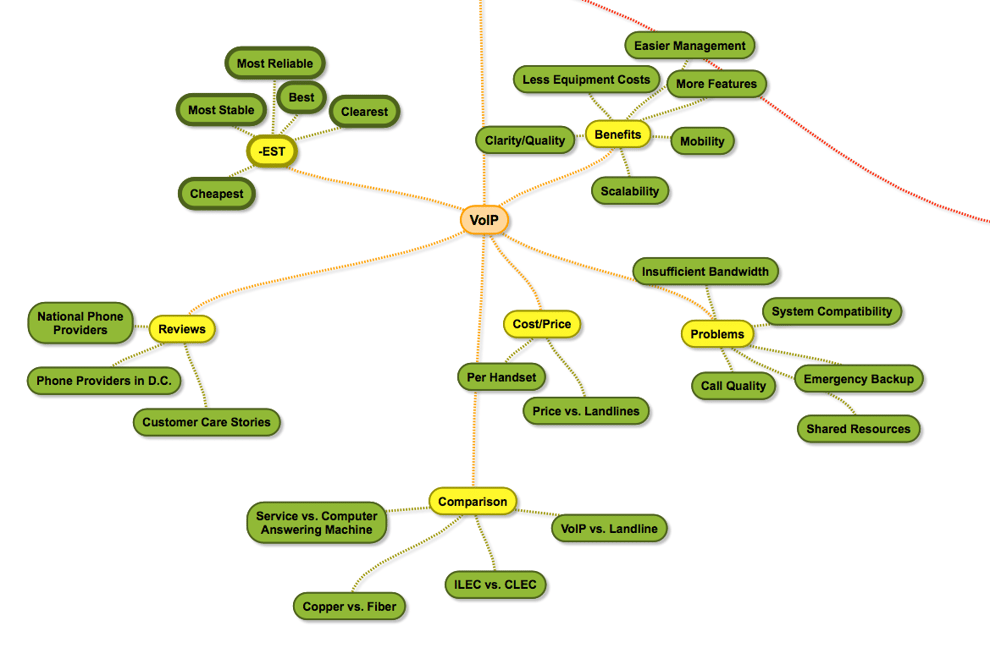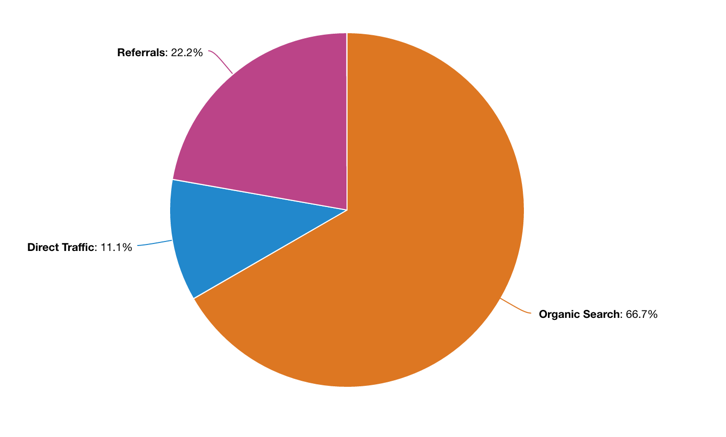What's the first problem you face when you want to grow your business through your website?
You can create compelling offers, and craft the most amazing lead nurturing campaigns known to man, but if you don't have anyone to show them to, what good are they?
You need website traffic. Period.
Let's look at how Atlantech.net increased their monthly organic traffic by over 1000% and their monthly lead generation by 366% in just 12 months, without spending much at all on ads.
Growing a B2B Website With Organic Traffic
Getting to work with a company like Atlantech was a huge opportunity for us. Not only do they offer a level of service and support their competitors can't match, they understand marketing. In our first meetings together, you could tell they "got" the inbound strategy, and they were bought in to the process. The results in this article are a testament to that.
A lot of businesses understand the need for traffic. So, they run out and invest thousands of dollars in Google and Facebook ads. And, they generate some pretty good traffic. But buying traffic gets more competitive every year. Thus, it gets more expensive every year.
The more ad competition, the more ads, the more people are blind to even the most creative copy.
Long story short, ads are getting more expensive and less effective.
While paid traffic is still an effective way to drive customers, it isn't as effective or cost-efficient as it once was.
What is still as effective as ever? Organic traffic.
A lot of people say organic traffic is free traffic. It's not. You have to invest either money or time in creating the kind of content people want if you want to grow your organic traffic.
The great thing about organic traffic is that investments are compounded, generating a snowballing effect on your website traffic.
A Tale of Two January's
In this case study, we're going to be comparing two months, January 2016, and January 2017. To understand what happens, let's look at the total traffic of January, 2016.

- Total Traffic: 1,769
- Organic Traffic: 1088
Organic was already 61% of the total website traffic. But, with less than 2,000 visitors hitting our website each month, we weren't generating very many leads. And few leads means few sales opportunities.
With a few conversion funnels in place, we decided to align most of our budget and effort to solving the traffic problem. We decided if we could hit 10,000 monthly website visitors, we would be in good shape to start tweaking our conversion and nurturing funnels to deliver more sales-ready opportunities.
Without spending a dime on ads, we focused on creating content on the blog. We didn't get too fancy or try to "disrupt" the industry with our knowledge.
Instead, we took a much simpler approach: address customer questions and concerns.
So, we started picking Atlantech Online's brains for the problems, pain points, and concerns their potential customers were facing.
We relied heavily on two documents to drive our strategy:
Having these documents fine-tuned to the problems our target audience was facing, along with their pain points, wants, and aspirations - we set to work creating a content marketing strategy that would give us a snowballing traffic month over month.
The First Signs of Growth
What a lot of companies don't understand is that, when you're focused on building an organic traffic engine, results don't show up overnight. It's not even a linear investment.
The traffic scale should have a hockey stick effect, when things are working well. That means you'll have a few months experiencing the "handle" of the hockey stick before you ever get to the blade.
And, Atlantech was no exception. With our eyes on a 10,000/month goal, it took us 7 months to hit 5,000. Well, actually in month 7, we fell 5 short, for a total traffic of 4,995.
Seven months.

Most people would be pulling the plug, thinking they were investing in something that just wasn't going to bring the results they wanted. But, Tom Collins and Ed Fineran of Atlantech were fully bought-in to the strategy. They understood, it's a long-term game we were playing, not a quick-win flash in the pan.
July 2016 Report
- Total Traffic: 4,995
- Organic Traffic: 4,138
Now, that's a 280% increase in monthly organic traffic - which is nothing to thumb your nose at. That's a significant increase. But after 7 months and being halfway to our goal, we were getting a little impatient.
We knew our strategy would work; we just had to keep our heads down and trust the process - let the hockey stick come in its own time.
Getting Some Lift Under Our Wings
It took seven months to increase our total traffic from 1,700 a month, to 5,000 a month.
But, that was changing quickly.
One of our favorite charts to watch is the percentage month-over-month growth chart in HubSpot. And every day we were logging in to see 23-40% increases in our traffic numbers compared to the previous month. And we were picking up speed.
Three months later, we blew the doors off our goal of 10,000.
In October of 2016, we totaled 11,118 visits.

Do you see what was happening?
- From 1,700 to 5,000 (an increase of 3,300/mo) = 7 months
- From 5,000 to 11,118 (an increase of 6,118/mo) = 3 months
This is the power of the snowball effect.
The Snowball Effect
In the world of content marketing, there are a lot of professionals that preach the big, thought-leadership style content. But, if you just simply answer the questions people ask Google, you can slowly build your SEO footprint.
Rather than relying on a "Hail Mary" strategy of "viral" content, we decided to make every post matter to the person using a search engine. At first, there's not much action - which is why traffic growth is slow in the beginning.
But, if you consistently write this kind of content, Google continues to give your domain more and more authority. In the beginning, our blog posts might have been hitting page 3-5 for our target SEO terms. We just didn't have the authority to hit page 1.
But, after a few months of publishing, Google is showing more love to all our blog posts. Now, with more authority, our newer content is hitting page 1 a lot sooner, and staying there.
As our domain authority rises, so does our ability to grow the traffic faster. That's why it took 210 days (give or take) to increase our traffic by 3,000, but it only took 90 days to increase it by over 6,000.
Around month 12, the liftoff really happened - as is often the case with building organic traffic.
Month 12 - January, 2017
- It took seven months to hit 5,000.
- It took 10 months to hit 10,000.
- It took 12 months to hit 15,000.
Total traffic topped 15,000 monthly visits in January, 12 months since we were sitting at a paltry 1,769.
In case you like numbers, that's a whopping 749% increase in monthly traffic in 12 months.

How Did Organic Traffic Perform?
- January 2016 = 1,088 organic visits.
- January 2017 = 13,021 organic visits.
In case you like numbers, that's a whopping 1096% increase in monthly organic traffic.

This massive increase in traffic has increased the number of organic leads coming into the system as well, by a factor of 366% monthly lead generation.
Future Battles are Plentiful
While we're thrilled with the increase in organic traffic, we really knew all along this would happen. We have done it many times before. Any client that buys-in for the long haul can experience this kind of growth as well.
But, I would be lying if I left you thinking it was all rainbows and unicorns.
As Atlantech is a local business, we were generating a lot of leads that were unqualified by virtue of being out of the serviceable area. So, even though our leads were up to a great number, it was even lower for qualified leads.
Since we had hit our traffic goal, we made a strategic decision to refocus some of that budget to generating, not just leads, but qualified, serviceable leads.
Case Study Recap
Part 1: The Challenge
Take a company website that was generating ZERO new customers, and turn it into a lead and customer generation tool. We needed to increase the amount of traffic, to increase the amount of leads, to increase the amount of opportunities, to increase the amount of customers.
Part 2: The Solution
First, we would take a Big-5 approach to content, writing posts that centered on answering our target customers' questions at all stages of the buying cycle. We levereged topic clusters to build authority for our website around our core topics of focus:
- Phone Service
- Fiber Internet Connectivity
- Data Center Services
Our topic clusters looked something like this:

Once we understood the areas of concern, and had a cluster of topics for most of them, we set a posting schedule. From January 2016 to January 2017, we published 86 blog articles. We also published 7 content-based lead magents and several other service-based lead magnets, like inline pricing quotes, and service availability in your area checker, things like that.
Part 3: The Results
Our domain authority is to the point that, even though we are publishing content much less frequently than before, our traffic continues to see explosive growth.
In March, organic traffic edged up to 15,500 visits, an increase of more than 2,000 monthly visits since January. Now that we've laid the foundation, we're seeing more traffic gains from less content creation. Google is simply sending over more traffic because of the immense reputation we've built with them by publishing so much inbound content on the website. That means our domain authority continues to grow and more of our blog articles are creeping higher in the search rankings each and every month.
We're averaging 70 leads per month, 66.7% of which are from organic traffic.
12.8% of our leads are identifiable "Qualified" leads.

We have dedicated our attention now, to a performance-based strategy, to increase qualified leads and sales opportunities to the same magnitude as our traffic. There are plenty of battles to fight before we can take a rest and let the website just "do its thing." (Not sure that ever happens) But, regardless of the battles on the horizon, it's sure fun to do Inbound Marketing when the payoff is 10X Organic Traffic.
And in reality, we're just getting started!